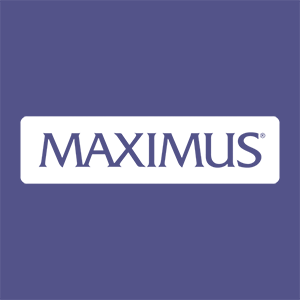
Maximus (MMS)
Maximus catches our eye. Its revenue and EPS are soaring, showing it can grow quickly and become more profitable as it scales.― StockStory Analyst Team
1. News
2. Summary
Why Maximus Is Interesting
With nearly 50 years of experience translating public policy into operational programs that serve millions of citizens, Maximus (NYSE:MMS) provides operational services, clinical assessments, and technology solutions to government agencies in the U.S. and internationally.
- Earnings per share grew by 16.8% annually over the last five years and trumped its peers
- Impressive 9.4% annual revenue growth over the last five years indicates it’s winning market share this cycle
- On the flip side, its demand will likely fall over the next 12 months as Wall Street expects flat revenue


Maximus shows some potential. If you believe in the company, the price looks fair.
Why Is Now The Time To Buy Maximus?
High Quality
Investable
Underperform
Why Is Now The Time To Buy Maximus?
At $84.86 per share, Maximus trades at 10.6x forward P/E. This multiple is lower than the broader business services space, and we think it’s fair given the revenue growth.
If you think the market is not giving the company enough credit for its fundamentals, now could be a good time to invest.
3. Maximus (MMS) Research Report: Q3 CY2025 Update
Government services provider Maximus (NYSE:MMS) fell short of the markets revenue expectations in Q3 CY2025, with sales flat year on year at $1.32 billion. The company’s full-year revenue guidance of $5.33 billion at the midpoint came in 4.5% below analysts’ estimates. Its non-GAAP profit of $1.62 per share was 3% below analysts’ consensus estimates.
Maximus (MMS) Q3 CY2025 Highlights:
- Revenue: $1.32 billion vs analyst estimates of $1.34 billion (flat year on year, 1.7% miss)
- Adjusted EPS: $1.62 vs analyst expectations of $1.67 (3% miss)
- Adjusted EBITDA: $160.2 million vs analyst estimates of $166.6 million (12.2% margin, 3.8% miss)
- Adjusted EPS guidance for the upcoming financial year 2026 is $8.10 at the midpoint, beating analyst estimates by 6.2%
- EBITDA guidance for the upcoming financial year 2026 is $729 million at the midpoint, above analyst estimates of $711.8 million
- Operating Margin: 9.3%, in line with the same quarter last year
- Free Cash Flow Margin: 48.7%, up from 10% in the same quarter last year
- Market Capitalization: $4.38 billion
Company Overview
With nearly 50 years of experience translating public policy into operational programs that serve millions of citizens, Maximus (NYSE:MMS) provides operational services, clinical assessments, and technology solutions to government agencies in the U.S. and internationally.
Maximus operates through three segments: U.S. Federal Services, U.S. Services, and Outside the U.S. The company manages large-scale government programs including healthcare enrollment, benefits administration, and clinical assessments. About half of its revenue comes from U.S. federal agencies, with state governments accounting for another third.
In its U.S. Federal Services segment, Maximus operates contact centers for Medicare and the federal health insurance marketplace, handles student loan servicing under the Aidvantage brand, and conducts medical disability examinations for veterans. For example, when a veteran needs to have their disability status evaluated, Maximus manages the clinical assessment process on behalf of the Department of Veterans Affairs.
The U.S. Services segment focuses on state-level programs, particularly Medicaid eligibility and enrollment services. The company also performs clinical assessments to determine eligibility for long-term care services and provides employment services that help welfare recipients transition to sustainable employment.
Internationally, Maximus delivers similar services, including employment programs and health assessments in countries like the United Kingdom and Australia. For instance, in the UK, the company conducts functional assessments for disability benefits under contract with the Department for Work and Pensions.
Maximus generates revenue primarily through performance-based contracts where payment depends on transaction volume or achieving specific outcomes. The company has been expanding its technology capabilities, offering services in application development, cybersecurity, and advanced analytics to help government agencies modernize their systems and improve service delivery.
4. Government & Technical Consulting
The sector has historically benefitted from steady government spending on defense, infrastructure, and regulatory compliance, providing firms long-term contract stability. However, the Trump administration is showing more willingness than previous administrations to upend government spending and bloat. Whether or not defense budgets get cut, the rising demand for cybersecurity, AI-driven defense solutions, and sustainability consulting should benefit the sector for years, as agencies and enterprises seek expertise in navigating complex technology and regulations. Additionally, industrial automation and digital engineering are driving efficiency gains in infrastructure and technical consulting projects, which could help profit margins.
Maximus competes with government insourced operations and other service providers including General Dynamics Information Technology, Deloitte, Leidos, Accenture, Booz Allen Hamilton, and Conduent. In international markets, competitors include Serco, Capita, and Atos.
5. Revenue Growth
Reviewing a company’s long-term sales performance reveals insights into its quality. Any business can put up a good quarter or two, but many enduring ones grow for years.
With $5.43 billion in revenue over the past 12 months, Maximus is one of the larger companies in the business services industry and benefits from a well-known brand that influences purchasing decisions.
As you can see below, Maximus’s sales grew at an impressive 9.4% compounded annual growth rate over the last five years. This shows it had high demand, a useful starting point for our analysis.

Long-term growth is the most important, but within business services, a half-decade historical view may miss new innovations or demand cycles. Maximus’s annualized revenue growth of 5.2% over the last two years is below its five-year trend, but we still think the results were respectable. 
This quarter, Maximus’s $1.32 billion of revenue was flat year on year, falling short of Wall Street’s estimates.
Looking ahead, sell-side analysts expect revenue to grow 4.1% over the next 12 months, similar to its two-year rate. This projection is underwhelming and indicates its products and services will see some demand headwinds.
6. Operating Margin
Operating margin is one of the best measures of profitability because it tells us how much money a company takes home after subtracting all core expenses, like marketing and R&D.
Maximus’s operating margin might fluctuated slightly over the last 12 months but has generally stayed the same, averaging 8.5% over the last five years. This profitability was mediocre for a business services business and caused by its suboptimal cost structure.
Looking at the trend in its profitability, Maximus’s operating margin might fluctuated slightly but has generally stayed the same over the last five years. This raises questions about the company’s expense base because its revenue growth should have given it leverage on its fixed costs, resulting in better economies of scale and profitability.
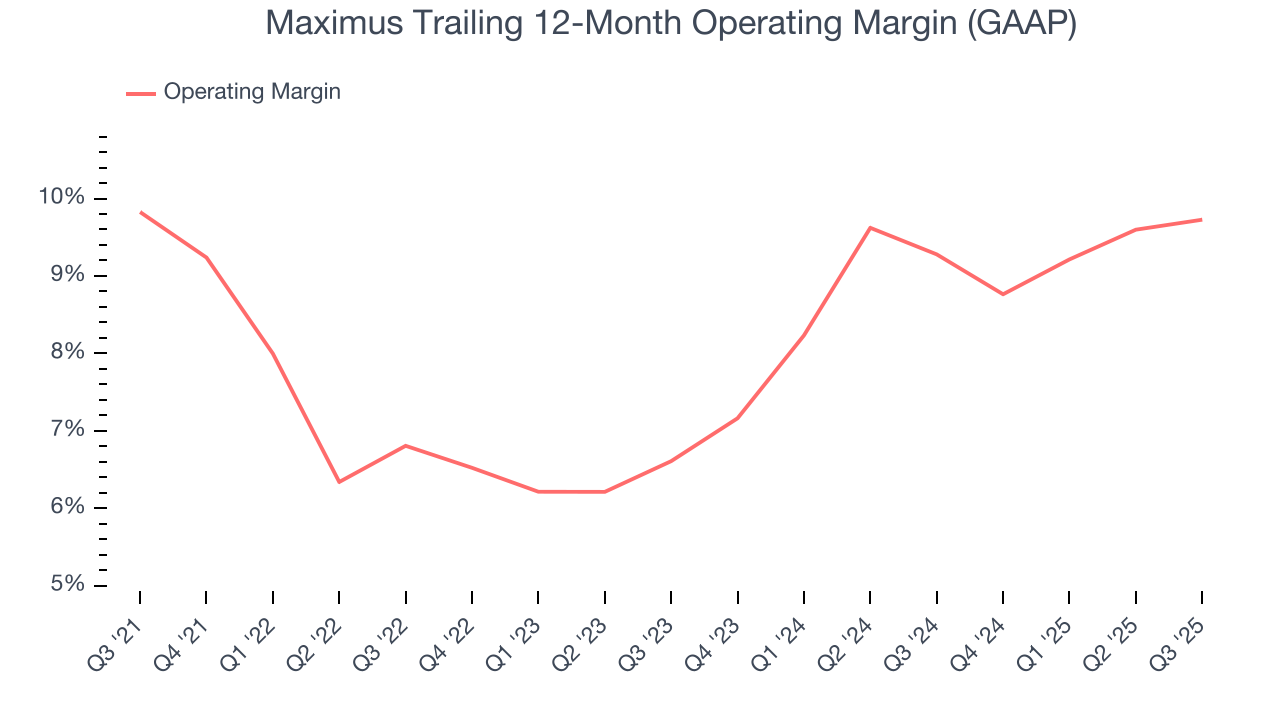
In Q3, Maximus generated an operating margin profit margin of 9.3%, in line with the same quarter last year. This indicates the company’s overall cost structure has been relatively stable.
7. Earnings Per Share
Revenue trends explain a company’s historical growth, but the long-term change in earnings per share (EPS) points to the profitability of that growth – for example, a company could inflate its sales through excessive spending on advertising and promotions.
Maximus’s EPS grew at an astounding 16.8% compounded annual growth rate over the last five years, higher than its 9.4% annualized revenue growth. However, this alone doesn’t tell us much about its business quality because its operating margin didn’t improve.

Like with revenue, we analyze EPS over a more recent period because it can provide insight into an emerging theme or development for the business.
For Maximus, its two-year annual EPS growth of 34.8% was higher than its five-year trend. We love it when earnings growth accelerates, especially when it accelerates off an already high base.
In Q3, Maximus reported adjusted EPS of $1.62, up from $1.46 in the same quarter last year. Despite growing year on year, this print missed analysts’ estimates, but we care more about long-term adjusted EPS growth than short-term movements. Over the next 12 months, Wall Street expects Maximus’s full-year EPS of $7.40 to grow 3.1%.
8. Cash Is King
Free cash flow isn't a prominently featured metric in company financials and earnings releases, but we think it's telling because it accounts for all operating and capital expenses, making it tough to manipulate. Cash is king.
Maximus has shown decent cash profitability, giving it some flexibility to reinvest or return capital to investors. The company’s free cash flow margin averaged 6.9% over the last five years, slightly better than the broader business services sector.
Taking a step back, we can see that Maximus’s margin dropped by 4.6 percentage points during that time. If its declines continue, it could signal increasing investment needs and capital intensity.
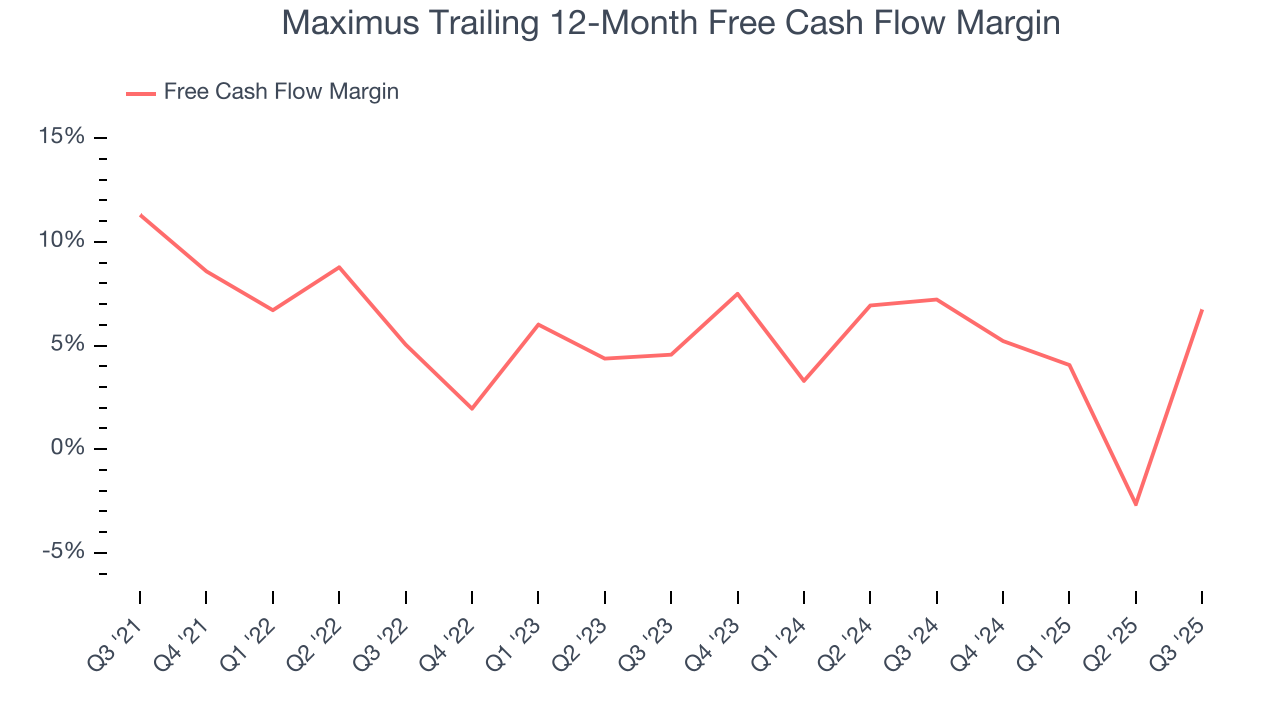
Maximus’s free cash flow clocked in at $641.8 million in Q3, equivalent to a 48.7% margin. This result was good as its margin was 38.7 percentage points higher than in the same quarter last year, but we wouldn’t read too much into the short term because investment needs can be seasonal, leading to temporary swings. Long-term trends are more important.
9. Return on Invested Capital (ROIC)
EPS and free cash flow tell us whether a company was profitable while growing its revenue. But was it capital-efficient? A company’s ROIC explains this by showing how much operating profit it makes compared to the money it has raised (debt and equity).
Maximus historically did a mediocre job investing in profitable growth initiatives. Its five-year average ROIC was 11.8%, somewhat low compared to the best business services companies that consistently pump out 25%+.
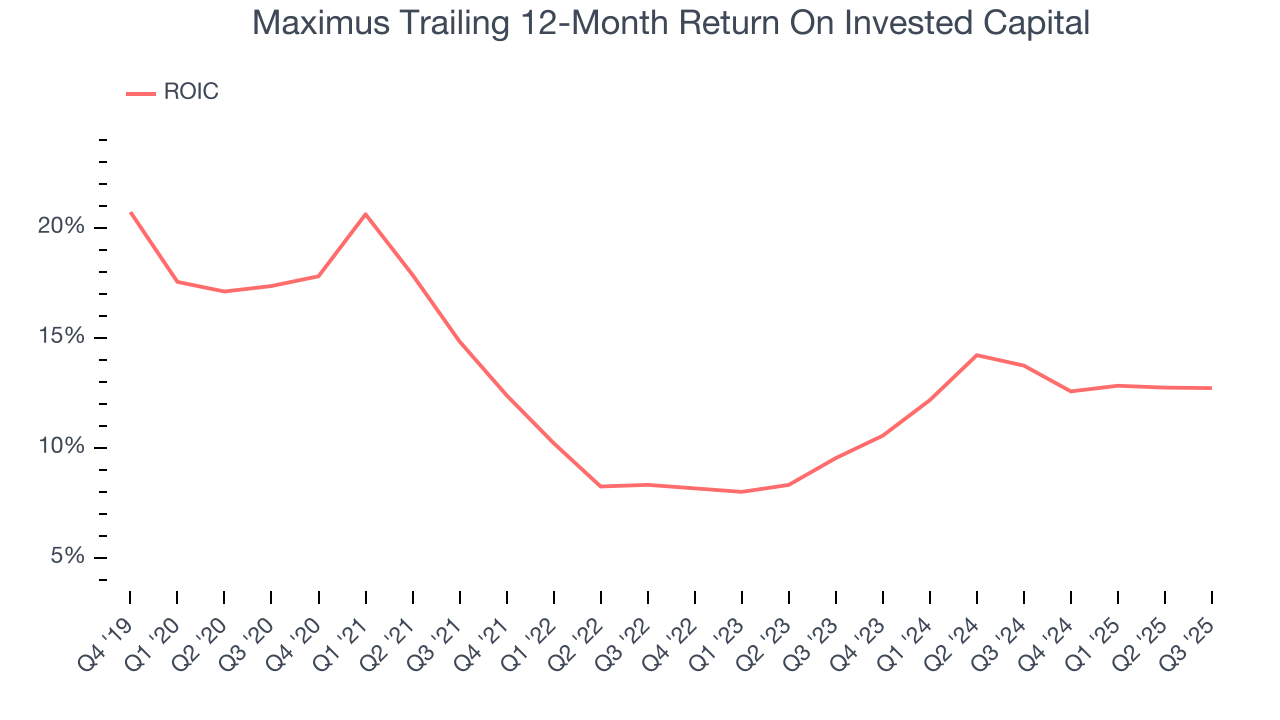
We like to invest in businesses with high returns, but the trend in a company’s ROIC is what often surprises the market and moves the stock price. On average, Maximus’s ROIC increased by 1.7 percentage points annually over the last few years. This is a good sign, and if its returns keep rising, there’s a chance it could evolve into an investable business.
10. Balance Sheet Assessment
Maximus reported $222.4 million of cash and $1.44 billion of debt on its balance sheet in the most recent quarter. As investors in high-quality companies, we primarily focus on two things: 1) that a company’s debt level isn’t too high and 2) that its interest payments are not excessively burdening the business.
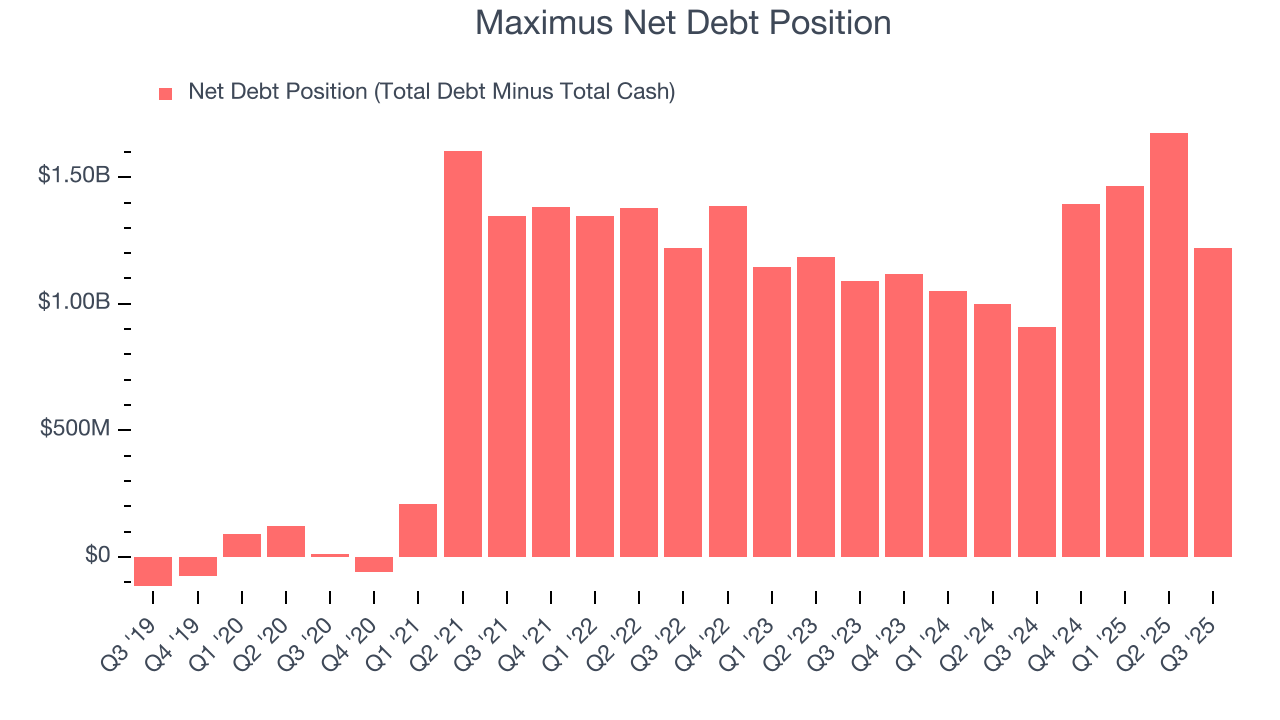
With $701.6 million of EBITDA over the last 12 months, we view Maximus’s 1.7× net-debt-to-EBITDA ratio as safe. We also see its $39.22 million of annual interest expenses as appropriate. The company’s profits give it plenty of breathing room, allowing it to continue investing in growth initiatives.
11. Key Takeaways from Maximus’s Q3 Results
We were impressed by how significantly Maximus blew past analysts’ full-year EPS guidance expectations this quarter. On the other hand, its full-year revenue guidance missed and its revenue fell short of Wall Street’s estimates. Overall, this quarter could have been better. The stock remained flat at $77.76 immediately following the results.
12. Is Now The Time To Buy Maximus?
Updated: December 3, 2025 at 11:30 PM EST
Before making an investment decision, investors should account for Maximus’s business fundamentals and valuation in addition to what happened in the latest quarter.
We think Maximus is a good business. To kick things off, its revenue growth was impressive over the last five years. And while its cash profitability fell over the last five years, its astounding EPS growth over the last five years shows its profits are trickling down to shareholders. On top of that, its projected EPS for the next year implies the company will continue generating shareholder value.
Maximus’s P/E ratio based on the next 12 months is 10.6x. Looking at the business services space right now, Maximus trades at a compelling valuation. If you’re a fan of the business and management team, now is a good time to scoop up some shares.
Wall Street analysts have a consensus one-year price target of $110 on the company (compared to the current share price of $84.86), implying they see 29.6% upside in buying Maximus in the short term.










